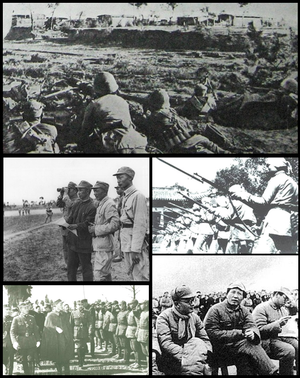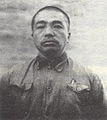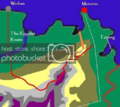Long War
| Long War 長期戰爭/长期战争 | |||||||
|---|---|---|---|---|---|---|---|
 | |||||||
| |||||||
| Main Belligerents | |||||||
|
Supported by: |
Supported by: | ||||||
| Commanders and leaders | |||||||
| Strength | |||||||
|
X million (regular) X million (military) |
X million (regular) X million (military) | ||||||
| Casualties and losses | |||||||
| xxx dead or missing, xxx wounded, xxx captured | xxx dead or missing, xxx wounded, xxx captured | ||||||
The Long War or War of Imperialist Aggression was an ideological conflict in Ide Jima. The incumbent Imperialist dynasties were threatened by revolutionary communists. Tensions boiled over when a number of protesters were fired upon and killed during a worker's protest at the then Imperial palace in the nation's capital. The conflict first began with many nations taking sides and sending support to one of the two main factions, Imperialists and Communists. The conflict then escalated into a total war. The conflict lasted from the 1930s into the 1950s, hence the name The Long War. The eventual outcome was a communist victory.[1]
Background
The incumbent Imperialist dynasties were threatened by revolutionary communists. Tensions boiled over when a number of protesters were fired upon and killed during a worker's protest at the then Imperial palace in the nation's capital.
Major factions
- Imperialists, led by Emperor Mitsuhiran III.
- Communists, led by Marshals Chang, Ryuzen, and Zatoichi.
War
This article is incomplete because it is pending further input from participants, or it is a work-in-progress by one author. Please comment on this article's talk page to share your input, comments and questions. Note: To contribute to this article, you may need to seek help from the author(s) of this page. |
(WIP. This conflict is supposed to be a combination of the Chinese civil war and later Korean War. Communist revolution, followed by trench warfare, and eventual communist victory. There will need to be technological innovations between the beginning and end of this conflict.)
- 1930s — Internal conflicts between imperialists and communists. (Where did these communists come from? Why where the imperialists weak enough to be attacked?)
- 1933-35
- 1933 — Communist uprising in the north. Imperialists were less motivated to fight their brothers and die for the emperor.
- 1934 — Led to an early stalemate.
- 1935-40 — The conflict evolved into a proxy war when outside actors took sides and sent support to one of the two main sides, Imperialists and Communists. (No foreign boots on the ground.)
- 1940-45 — The conflict then escalated into a total war within Ide Jima (akin to World War I).
- Severe famines in 1942-43.
- 1945-50
- 1950-55
- 1954 — Battle of the Bridges at Toko-San. Imperialist forces pushed to destroy heavily protected bridges in communist territory. In the attack on the bridges, the anti-aircraft fire is intense. Imperialist jets managed to destroy the bridges, but with heavy losses, severely weakening the imperialist airpower. A Pyrrhic victory. With Imperialists lacking air cover, the communists launched a counter-offensive with ground troops. The communists successfully overwhelmed the Imperialist positions. This decisively shifted the balance of power towards the communist side.
- 1955 — Communists clearly on the winning side.
- 1956 — Peace conference. The monarchy in Ide Jima was abolished.
Aftermath
The eventual outcome was a communist victory. Officially, from 1956 to 1992, Ide Jima was governed by a hard line communist government.
References
- ↑ The Long War (7 November 2005)







